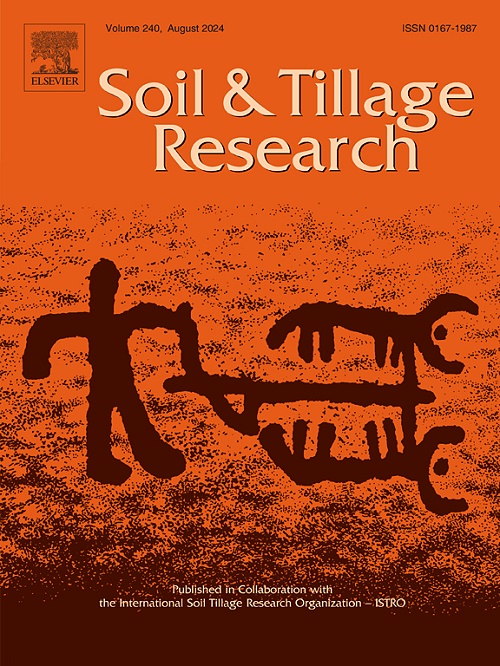Faster soil organic carbon turnover in MAOM versus POM: straw input causes larger microbial driven soil organic carbon decomposition but higher straw accumulation in MAOM
IF 6.1
1区 农林科学
Q1 SOIL SCIENCE
引用次数: 0
Abstract
Straw-related carbon (C) dynamics are central for soil organic C (SOC) accrual in soils. However, the underlying microbial groups driving straw decomposition and accumulation in particulate organic matter (POM) and mineral-associated organic matter (MAOM) remain elusive. This study effectively isolated POM and MAOM by using ultrasonic energy (kept below 80 J mL−1) and size-density fractionation that minimally impacts microbial activity and community. We further conducted an 87-day incubation to examine the transformation of added C4 straw and the involved bacterial mechanisms in POM and MAOM. Here, we showed that: i) SOC turnover was faster in MAOM compared to POM, as MAOM stabilized more straw C, likely through strong organic-mineral interactions, while exhibiting significantly higher SOC mineralization than POM over the incubation period; and ii) MAOM, versus POM, exhibited difference of bacterial community and metabolisms during incubation. For instance, microorganisms within MAOM were enriched with genes involved in i) decomposing easily utilized C sources (e.g., sugars, pectin) and ii) the pathways of microbial biomass synthesis. This led to faster SOC turnover via larger native SOC decomposition (possibly through co-metabolism mechanisms) and higher new SOC formation (possibly through biomass-necromass accumulation). Conversely, POM enriched with K-strategists and genes encoding enzymes decomposing recalcitrant C sources (e.g., cellulose, hemicellulose, lignin), possibly via nitrogen mining as nutrients were exhausted in the later stage. This study firstly reveals the bacterial drivers involved in straw-C transformation within POM and MAOM by proper separating approach and highlights the different bacterial community and their metabolisms underpinning added straw decomposition and consequent C accrual in POM and MAOM.
与POM相比,MAOM土壤有机碳周转更快:秸秆投入导致微生物驱动的土壤有机碳分解更大,但MAOM的秸秆积累量更高
秸秆相关碳(C)动态是土壤有机碳(SOC)积累的核心。然而,驱动秸秆分解和颗粒有机质(POM)和矿物相关有机质(MAOM)积累的潜在微生物群仍然难以捉摸。本研究采用超声波能量(保持在80 J mL−1以下)和粒径-密度分馏法有效分离POM和MAOM,对微生物活性和群落影响最小。我们进一步进行了87天的培养,以研究添加C4秸秆在POM和MAOM中的转化及其涉及的细菌机制。本研究表明:1)与POM相比,MAOM的有机碳转换速度更快,因为MAOM可能通过强烈的有机-矿物相互作用稳定了更多的秸秆C,同时在孵化期内表现出明显高于POM的有机碳矿化;ii) MAOM与POM在孵育过程中表现出细菌群落和代谢的差异。例如,MAOM内的微生物富含参与i)分解容易利用的碳源(如糖、果胶)和ii)微生物生物量合成途径的基因。这导致更快的有机碳周转,通过更大的天然有机碳分解(可能通过共同代谢机制)和更高的新有机碳形成(可能通过生物量-坏死块积累)。相反,POM富含钾策略和编码酶的基因,这些酶可以分解顽固的碳源(如纤维素、半纤维素、木质素),可能是通过氮挖掘,因为养分在后期耗尽。本研究首次通过适当的分离方法揭示了POM和MAOM中参与秸秆-C转化的细菌驱动因素,并强调了POM和MAOM中秸秆分解和C积累的不同细菌群落及其代谢机制。
本文章由计算机程序翻译,如有差异,请以英文原文为准。
求助全文
约1分钟内获得全文
求助全文
来源期刊

Soil & Tillage Research
农林科学-土壤科学
CiteScore
13.00
自引率
6.20%
发文量
266
审稿时长
5 months
期刊介绍:
Soil & Tillage Research examines the physical, chemical and biological changes in the soil caused by tillage and field traffic. Manuscripts will be considered on aspects of soil science, physics, technology, mechanization and applied engineering for a sustainable balance among productivity, environmental quality and profitability. The following are examples of suitable topics within the scope of the journal of Soil and Tillage Research:
The agricultural and biosystems engineering associated with tillage (including no-tillage, reduced-tillage and direct drilling), irrigation and drainage, crops and crop rotations, fertilization, rehabilitation of mine spoils and processes used to modify soils. Soil change effects on establishment and yield of crops, growth of plants and roots, structure and erosion of soil, cycling of carbon and nutrients, greenhouse gas emissions, leaching, runoff and other processes that affect environmental quality. Characterization or modeling of tillage and field traffic responses, soil, climate, or topographic effects, soil deformation processes, tillage tools, traction devices, energy requirements, economics, surface and subsurface water quality effects, tillage effects on weed, pest and disease control, and their interactions.
 求助内容:
求助内容: 应助结果提醒方式:
应助结果提醒方式:


